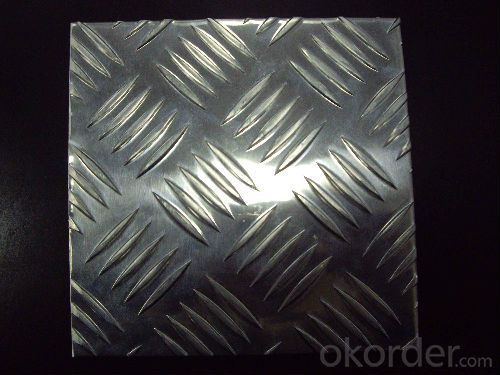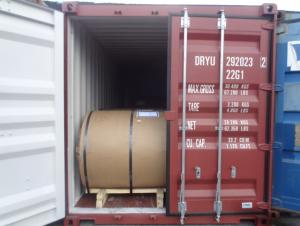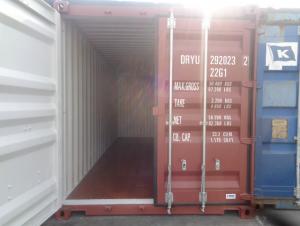Checkered Stainless Steel Sheet With Best Price In Stocks
- Loading Port:
- Shanghai
- Payment Terms:
- TT or LC
- Min Order Qty:
- 4 m.t.
- Supply Capability:
- 4000 m.t./month
OKorder Service Pledge
OKorder Financial Service
You Might Also Like
1.Structure of Product Description
Stainless steel sheet/STAINLESS STEEL PLATE is widely used in the field of construction field and decoration field, etc. There are many different grades, such as: 200 series, 300 series, 400 series, 900series, etc. The detailed grade are as follows: 201, 202, 301, 304, 316, 410, 420, 430, etc.
The surface is including 2B, BA, Mirror Finish, Checkered, etc.
2. Main features of the product
b. Frist-Class Service.
c. Shortest service.
3. Image.

4. Product detailed sizes:
1000mm*2000mm,1250mm*2500mm,1500mm*3000mm, etc.
5. FAQ:
What is the quality standard?
---Usually our standard is GB3880-2006 or else.
What is the width range?
---It is from 1000mm to 2500mm, etc.
What is the length range?
---It is from 2000mm to 6000mm, etc.
What is the MOQ for your products yet?
---Normally it is around 5 tons/each size.
How many tons did you export in one year?
---Normally it is around 9000 tons totally.
---Normally it is from USA, UAE, ENGLAND, ETC.
what is your mainly products?
---Normally they are stainless steel sheet, stainless steel coil, stainless steel checkered sheet, stainless steel mirror finished sheet, color coated stainless steel sheet, etc.
- Q:What are the different types of stainless steel sheet alloys available?
- There are several different types of stainless steel sheet alloys available, each offering unique properties and characteristics. Some of the most common stainless steel sheet alloys include: 1. Austenitic Stainless Steel: This type of stainless steel is the most widely used and versatile. It is non-magnetic and contains high levels of chromium and nickel, offering excellent corrosion resistance and good formability. Austenitic stainless steel alloys include 304 and 316 grades. 2. Ferritic Stainless Steel: Ferritic stainless steel is magnetic and contains high levels of chromium. It has good corrosion resistance and is typically less expensive than austenitic stainless steel. Common ferritic stainless steel alloys include 430 and 446 grades. 3. Martensitic Stainless Steel: Martensitic stainless steel is magnetic and contains high levels of carbon and chromium. It is known for its hardness and strength, making it suitable for applications requiring high wear resistance. Martensitic stainless steel alloys include 410 and 420 grades. 4. Duplex Stainless Steel: Duplex stainless steel is a combination of austenitic and ferritic stainless steels, offering a balance of both their properties. It has increased strength and corrosion resistance compared to austenitic stainless steel. Common duplex stainless steel alloys include 2205 and 2507 grades. 5. Precipitation Hardening Stainless Steel: Precipitation hardening stainless steel alloys are heat treatable and can achieve high strength levels. They contain elements such as copper, aluminum, or titanium, which form precipitates during heat treatment, resulting in increased strength. Common precipitation hardening stainless steel alloys include 17-4PH and 15-5PH grades. It is important to consider the specific requirements of your application when selecting a stainless steel sheet alloy, as each alloy has its own strengths and limitations.
- Q:Is stainless steel plate permitted to contact galvanized material?
- If your products are not immersed in the electrolyte (not put in wet or condensed water place), just hope galvanized plate itself does not corrode, consider using stainless steel screws, but doing so will occur between stainless steel bolts and steel carburizing, stainless steel bolt rust damage lost the meaning of stainless steel bolt. The reason why stainless steel is corroded at this time is called intergranular corrosion".
- Q:Can stainless steel sheets be used in high-pressure applications?
- Stainless steel sheets are indeed applicable in high-pressure scenarios. Renowned for its remarkable resistance to corrosion and impressive strength, stainless steel is suitable for a variety of industrial uses, especially those involving high-pressure conditions. Its exceptional strength enables it to endure the force exerted by high-pressure fluids or gases without distorting or breaking. Moreover, stainless steel sheets can be shaped and sized as desired, facilitating their utilization in a wide array of high-pressure applications such as pressure vessels, pipelines, hydraulic systems, and heat exchangers. All in all, stainless steel sheets are a dependable and long-lasting option for high-pressure circumstances due to their inherent strength and corrosion resistance characteristics.
- Q:Are stainless steel sheets suitable for outdoor railings?
- Indeed, outdoor railings can be made from stainless steel sheets. Renowned for their resistance to corrosion and remarkable durability, stainless steel sheets are a favored selection for outdoor purposes. Furthermore, they possess the ability to endure adverse weather conditions, such as rain, snow, and UV radiation, without compromising their structural integrity or visual appeal. As a result, stainless steel railings require minimal maintenance and are effortlessly cleaned, rendering them a practical and enduring choice for outdoor areas. In addition to their practicality, stainless steel sheets provide a sleek and contemporary aesthetic, elevating the overall appearance and ambiance of any outdoor railing system.
- Q:What are the different types of colored finishes available for stainless steel sheets?
- Stainless steel sheets come in a variety of colored finishes that serve to enhance their appearance and offer different aesthetic options. Some of the most popular colored finishes include: 1. Mirror Finish: This particular finish achieves a highly reflective, mirror-like surface on the stainless steel sheets. By polishing the stainless steel surface to a high gloss, a sleek and modern look is achieved. Mirror finishes are commonly used for decorative purposes. 2. Satin Finish: Also known as a brushed or matte finish, this type of finish provides a smooth, non-reflective surface. It is achieved by brushing the stainless steel surface with an abrasive material. Satin finishes are commonly used in architectural and industrial applications, giving off a clean and contemporary appearance. 3. Colored Powder Coating: This finish involves applying a dry powder to the stainless steel surface and then curing it under heat. The result is a durable and uniform colored finish. Colored powder coatings offer a wide range of hues, allowing for customization and versatility in design. 4. PVD Coating: The process of Physical Vapor Deposition (PVD) entails depositing a thin layer of metal onto the stainless steel surface. This coating can be in various colors, such as gold, bronze, black, or rose gold. PVD coatings are highly durable and resistant to wear, making them suitable for high-traffic areas or decorative applications. 5. Colored Anodizing: This finish is achieved through an electrochemical process that creates a protective oxide layer on the stainless steel surface. By incorporating dyes into the anodizing process, a plethora of colors can be achieved. Colored anodized finishes are known for their corrosion resistance and find utility in architectural or design-oriented applications. Each of these colored finishes possesses unique characteristics and can be selected based on desired aesthetics, durability, and specific application requirements. It is crucial to consider factors such as maintenance requirements, environmental conditions, and intended use when choosing a colored finish for stainless steel sheets.
- Q:Are stainless steel sheets suitable for storage tanks?
- Yes, stainless steel sheets are suitable for storage tanks. Stainless steel is a highly durable and corrosion-resistant material, making it an ideal choice for storing various substances. It offers excellent resistance to rust and corrosion, ensuring that the tank remains intact and free from leaks. Stainless steel also has a high strength-to-weight ratio, allowing for the construction of large storage tanks without sacrificing structural integrity. Additionally, stainless steel is easy to clean and maintain, making it a hygienic choice for storing food-grade or pharmaceutical substances. Overall, stainless steel sheets are a reliable and long-lasting option for storage tanks in various industries.
- Q:Can stainless steel sheets be used for kitchen appliances?
- Kitchen appliances can indeed utilize stainless steel sheets. The reason behind its popularity in this realm is its robustness, ability to resist corrosion, and effortless upkeep. Ovens, refrigerators, dishwashers, and other kitchen appliances are often crafted with this versatile material. It can be effortlessly molded into diverse shapes and sizes, accommodating a variety of appliance designs. Furthermore, stainless steel's sleek and contemporary aesthetics have made it the preferred option for countless homeowners and chefs.
- Q:How do you calculate the weight of a stainless steel sheet?
- To calculate the weight of a stainless steel sheet, you need to know its dimensions (length, width, and thickness) and the specific gravity of stainless steel. First, determine the volume of the stainless steel sheet by multiplying the length, width, and thickness together. This will give you the volume in cubic units. Next, multiply the volume by the specific gravity of stainless steel, which is typically around 7.93 g/cm³ (grams per cubic centimeter). This will give you the weight of the stainless steel sheet in grams. To convert the weight to a different unit, such as kilograms or pounds, divide the weight in grams by the appropriate conversion factor. For example, to convert grams to kilograms, divide by 1000. To convert grams to pounds, divide by 453.59237. It is important to note that this calculation provides an estimate of the weight, as there may be slight variations in the specific gravity of stainless steel depending on the exact alloy and composition of the sheet.
- Q:What's the difference between stainless steel hot rolling and cold rolling?
- The difference between hot rolling and cold rolling of stainless steel is that cold rolling is rolled on the basis of hot rolling.
- Q:Are stainless steel sheets suitable for automotive body panels?
- Absolutely! Automotive body panels can definitely benefit from the use of stainless steel sheets. This material is widely favored in the automotive industry because of its remarkable ability to resist corrosion and its exceptional durability. It can withstand even the harshest weather conditions, making it perfect for body panels. Moreover, stainless steel sheets provide a sleek and polished look, enhancing the overall aesthetic appeal of the vehicle. Furthermore, stainless steel offers a superior strength-to-weight ratio, resulting in better fuel efficiency and improved vehicle performance. In conclusion, stainless steel sheets are an incredibly reliable and long-lasting choice for automotive body panels.
1. Manufacturer Overview |
|
|---|---|
| Location | |
| Year Established | |
| Annual Output Value | |
| Main Markets | |
| Company Certifications | |
2. Manufacturer Certificates |
|
|---|---|
| a) Certification Name | |
| Range | |
| Reference | |
| Validity Period | |
3. Manufacturer Capability |
|
|---|---|
| a)Trade Capacity | |
| Nearest Port | |
| Export Percentage | |
| No.of Employees in Trade Department | |
| Language Spoken: | |
| b)Factory Information | |
| Factory Size: | |
| No. of Production Lines | |
| Contract Manufacturing | |
| Product Price Range | |
Send your message to us
Checkered Stainless Steel Sheet With Best Price In Stocks
- Loading Port:
- Shanghai
- Payment Terms:
- TT or LC
- Min Order Qty:
- 4 m.t.
- Supply Capability:
- 4000 m.t./month
OKorder Service Pledge
OKorder Financial Service
Similar products
New products
Hot products
Hot Searches
Related keywords






























